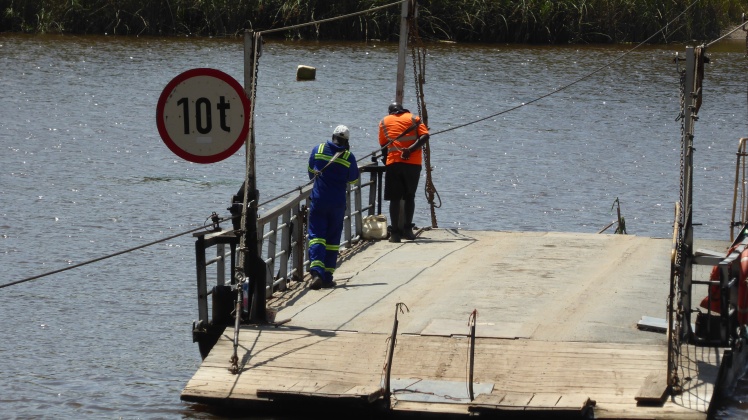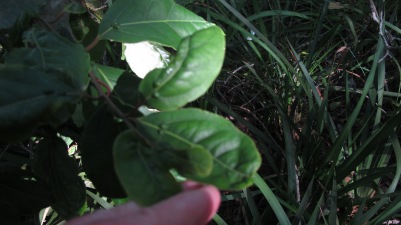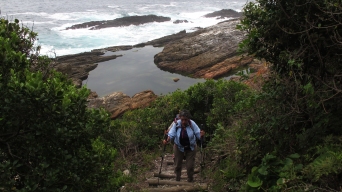
It was a long drive from De Hoop to our starting point for a 3-day hike on the Dolphin Trail. On the advice of Dixon, we took the “adventurous” route that included lots of dirt roads. You could see on-coming traffic for miles ahead by the telltale rooster tail of dust billowing behind any vehicle traveling on the road.


The highlight of the travel day was a ferry across the Maglas River. It’s a cable ferry powered by two burley men. It was fascinating to watch them strap a hefty chain to the taunt steel cable stretched across the river. The other end of the chain is fastened to a vest-like harness around the men’s torso. They literally pull the flatbed vessel through the water by walking back and forth along the length of the deck. When they reach the end, they unfasten the chain, walk to the opposite end, and repeat. Grueling work.
I asked if it was hard work, and they responded with vigorous head shakes to the affirmative. We made sure we provided a nice tip at the end of the 10-minute journey. This ferry is similar to the Whites Ferry across the Potomac River. Except the Jubal Early is motor powered.
In the crazy juxtaposition of the old and the new in South Africa, a camera drone hoovered nearby as we transited the river. Its subject seemed to be filming 2 young white boys frolicking in the water. They must have been staying at a very nice vacation house just beside the ferry dock.
 We arrived at Tsitsikamma National Park late in the afternoon and checked into a cute chalet overlooking the rocky shoreline. We met our guides Verner and Hershel and the other 10 members of our international hiking party.
We arrived at Tsitsikamma National Park late in the afternoon and checked into a cute chalet overlooking the rocky shoreline. We met our guides Verner and Hershel and the other 10 members of our international hiking party.
We had a relaxing evening in our cute chalet overlooking the rock shore and were lulled to sleep by the soothing sounds of the surf. We were warned to be prepared for rapid changes of weather and sure enough, to our dismay, it was raining when we awoke. Fortunately, it wasn’t too cold. The good news was that the rain washed the dusty film off our rental car.
Rain continued off and on during breakfast, but by the time we were ready to head off, the rain stopped. The trail began on a boardwalk that skirted the cove, then up and down a lot of steps. Just the beginning of countless more steps we would encounter on our 3-day hike.

Once we crested the hill you could see a wide river through the clearing. There were 3 impressive suspension bridges to cross over the Storms River. Built in 2009, they shortened the route considerably. Nonetheless, the trail profile was extremely steep. After crossing the river, it was a long steep climb up to the ridge top.

After about a 2 hour climb we reached an overlook at the top. There the outfitter supplied a catered snack that was trucked in. The juice, hot tea, and brownies were a welcomed treat after a strenuous climb. Jane marveled at the tea service. How civilized to have tea served in a cup and saucer while enjoying a panoramic view.

The ridge was bursting with native fynbos plants that looked like blooming heaths and heathers. The shrubs were dotted with white and pink flowers. We also saw a beautiful orange lily and protea, the national flower of South Africa.

After a harrowing climb down another steep mountainside, lunch was on a large swath of rocks on the shore. There was an opportunity to swim in a natural pool. Although we had our bathing suits on, we didn’t jump in. Only the hardy Danish took the plunge. They enjoyed the experience and said that the water wasn’t too cold. Given that their frame of reference are the Baltic and North Seas, I wasn’t convinced.
Our guides packed in sandwiches and drinks. I spent some time climbing around the rocks to hunt wildflowers nestled in the crannies. After lunch, it was another grueling climb up a steep mountainside. It was tricky maneuvering on the timber steps. The spacing between them varied a great deal and they were moist and slippery.

Once on top of the mountain there was still a distance to travel to the aptly named Misty Mountain Lodge. This is definitely one of the advantages of “slack-packing” where the outfitter arranges to transport your luggage from one site to the next. That eliminates the need to carry stuff on your hike.
We arrived at the very lovely lodge located on the edge of a high bluff overlooking the Indian Ocean. We were offered warm towels to wash hands and faces and a cooling welcome drink.
 The rooms were quite luxurious. We immediately took advantage of the heart shaped Jacuzzi. We later learned that we were staying in the honeymoon suite. Because of the high iron content in the water, our bubble bath took on a rust-colored hue. It didn’t faze us in the least and we reveled in the relaxing warmth. A perfect ending for a strenuous day hiking.
The rooms were quite luxurious. We immediately took advantage of the heart shaped Jacuzzi. We later learned that we were staying in the honeymoon suite. Because of the high iron content in the water, our bubble bath took on a rust-colored hue. It didn’t faze us in the least and we reveled in the relaxing warmth. A perfect ending for a strenuous day hiking.
After a nice nap, we went to the lounge to enjoy the warmth of a fire that took the dampness out of what turned into a rainy misty evening. We had a very nice dinner with good conversation including a discussion about the impact of Brexit with Alice and Jerry from the UK.

The next morning, we began with a long descent down the mountain through a dense forest. Verner pointed put some interesting plants including the stinkwood tree. The plant has the unique defense mechanism against pests. It forms blisters on its broad leaves near the stem It mimics the look of a plant infested with insect larvae. The appearance wards off invasion by real pests.

Once again, the trail was marked with lots of ups and downs, much of it over irregularly spaced steps. With the uneven spacing it’s hard to maintain a decent rhythm. Jane especially struggled, and somewhere along the way she must have twisted her leg. Her knee was badly swollen and her mobility was affected.
The trail followed the shoreline for a couple of kilometers. After reading the brochure descriptions we envisioned sandy beaches and beautiful coves. Instead, the actual coast was a massive rock cliff of awkwardly slanted thin strata of rock. The waves crashed against rocks and filled into tidal pools.

Transiting over the rock was a treacherous task. The angled rocks provided little surface to plant your feet. In some places, you had to lean your body inward against the rock face and shimmy across the narrow ledge.
There were 3 sections of these angled rocks over a 2 kilometer area interspersed with climbs up more dastardly steps. We took a snack break on the 2nd ledge. Sadly, there was no catered service here.
Our lead guide Werner asked if anyone wanted to go swimming in one of the tidal pools. Alice from the UK sarcastically mumbled, “sure, all it takes is a mad scramble across treacherous razor blade rocks, then remove you hiking attire for a frolic in the tepid water!” Even the Danes passed this opportunity.
 More up and down followed our route to the 3rd beach area. A big ascent up a crazy steep mountain. We were all quite tired at this point and the prospect of even more steps was demoralizing. The only good thing was the prospect of a catered lunch at the top.
More up and down followed our route to the 3rd beach area. A big ascent up a crazy steep mountain. We were all quite tired at this point and the prospect of even more steps was demoralizing. The only good thing was the prospect of a catered lunch at the top.
Jane and me plopped ourselves into camp chairs and guzzled about a gallon of water before thinking of food. The fantastic array included 2 quiches, chicken wings, chilled fruit, and a veggie Kabob, followed by tea and brownies. No question that this is a very upscale hiking experience.

They said the last 3 kilometers were a walk in the park. It certainly was no Baker Park. While nowhere near as difficult as the morning stretch, we nonetheless had more ups and downs than we bargained for.

Guide intern Hershal mostly took the sweep position at the end of our group. That meant that Jane and me became his best friends. Jane especially shared her interest and knowledge of plants. He couldn’t have been nicer or more patient with us. On many occasions, he took Jane by the hand to help her across rocks, steams and up steep inclines.
During November and December, springtime in the southern hemisphere, a variety of whales are frequently sighted. Even though dolphins are year-round residents, we didn’t sight a single one.

Thank you for taking us on this journey. Fascinating & Beautiful!
Sent from my iPhone
>
LikeLike
Goodness me ! What a wake up call for us the locals about the beauty that is so within reach. Will let you know how that pens out (school calendar allowing)
LikeLiked by 1 person
I hope you get an opportunity to “follow in our footsteps.” Keep in mind that you could also do portions as a day hike. Trekking over the 3 suspension bridges and a view from the overlook beyond would make a nice day.
LikeLike
Honor badges for completing such arduous terrain although the satisfaction of having done so must have been just as steep! Wonderfully written as always.
LikeLike